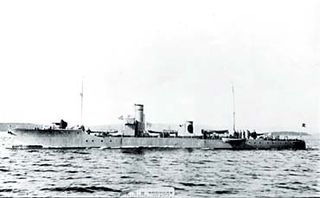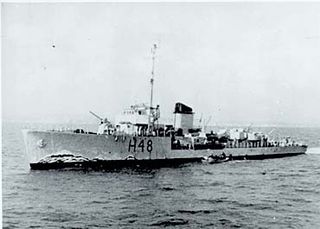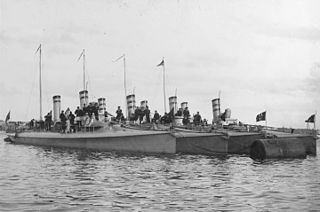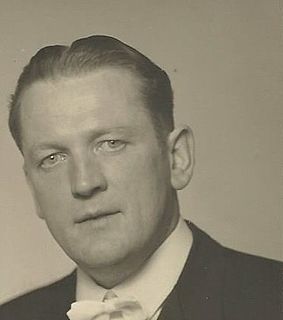
The Altmark incident was a naval incident of World War II between British destroyers and the German tanker Altmark, which happened on 16–17 February 1940. It took place in what were, at that time, neutral Norwegian waters. On board the Altmark were some 300 allied prisoners, whose ships had been sunk by the pocket battleship Graf Spee in the Southern Atlantic Ocean. British naval forces cornered the tanker and later the destroyer Cossack attacked the German ship near the Jøssingfjord and freed all the prisoners, killing eight German seamen with firearms and wounding ten others, five of them seriously. A British and a Norwegian sailor were also seriously wounded in the action. Germany claimed that the attack was a grave violation of international law and of Norwegian neutrality.
The German operation for the invasion of Denmark and Norway in April 1940 was code-named Weserübung, or "Weser Exercise." Opposing the invasion were the partially mobilized Norwegian military, and an allied expeditionary force composed of British, French, and Free Polish formations. The following list formed the order of battle for this campaign.

The Norwegian campaign was an attempted Allied occupation of northern Norway, during the early stages of World War II.

HMS Mohawk was one of 16 Tribal-class destroyers built for the Royal Navy shortly before the beginning of Second World War in 1939. Completed in 1938 the ship was initially assigned to the Mediterranean Fleet. She was briefly involved enforcing the arms blockade on the combatants in the Spanish Civil War in early 1939. Mohawk returned home shortly after the start of the Second World War and was assigned convoy escort duties, during which she was damaged by German bombers. She played an active role in the Norwegian Campaign of April–May 1940, escorting convoys to and from Norway.
The Norwegian Campaign, lasting from 9 April to 10 June 1940, led to the first direct land confrontation between the military forces of the Allies — United Kingdom and France — against Nazi Germany in World War II.

HNoMS Trygg was a torpedo boat of the Royal Norwegian Navy. Her hull was built in Moss and she was finished in Horten, with build number 109. Trygg had two sister ships: HNoMS Snøgg and HNoMS Stegg. Together the three vessels formed the Trygg class of torpedo boats.

Köln was a light cruiser, the third member of the Königsberg class that was operated between 1929 and March 1945, including service in World War II. She was operated by two German navies, the Reichsmarine and the Kriegsmarine. She had two sister ships, Königsberg and Karlsruhe. Köln was built by the Deutsche Werke shipyard in Kiel; she was laid down in August 1926, launched in May 1928, and commissioned into the Reichsmarine in 15 January 1930. She was armed with a main battery of nine 15 cm SK C/25 guns in three triple turrets and had a top speed of 32 knots.

Königsberg was a German light cruiser that was operated between 1929 and April 1940, including service in World War II. She was the lead vessel of her class and was operated by two German navies, the Reichsmarine and the Kriegsmarine. She had two sister ships, Karlsruhe and Köln. Königsberg was built by the Kriegsmarinewerft in Wilhelmshaven; she was laid down in April 1926, launched in March 1927, and commissioned into the Reichsmarine in April 1929. She was armed with a main battery of nine 15 cm SK C/25 guns in three triple turrets and had a top speed of 32 knots.

The Draug class was the first multi-vessel class of destroyers built for the Royal Norwegian Navy in the early 20th century and the first destroyers constructed for the Royal Norwegian Navy since Valkyrjen, which was commissioned on 17 May 1896. The class comprised three ships, Draug, Troll and Garm. All three were built at the naval shipyard at Horten. The Draug class were the last Norwegian-constructed destroyers until the Aalesund class was laid down in 1939. The Draug class saw service until the 1940s. In 1940, Garm was sunk while the other two remained in service until sold and broken up for scrap.

HNoMS Draug was the lead ship of the three-ship Draug class of destroyers built for the Royal Norwegian Navy in the years 1908–1913. The four-stacked destroyer was kept in service long after she was obsolete, and took part in the defence of Norway during the German invasion in 1940.

The destroyer HNoMS Troll, known locally as Torpedojager Troll, was the second destroyer built for the Royal Norwegian Navy, as the second ship of the Draug-class destroyers. She was built at the naval shipyard in Horten, with yard number 104. She was kept in service long after she was obsolete, and took part in the defence of Norway after the German invasion in 1940.
HNoMS Tyr was a Gor-class Rendel gunboat built for the Royal Norwegian Navy at Karljohansverns Verft Naval Yard in Horten. She was laid down in 1884 and launched in 1887 with build number 67. Tyr was one of a class of two gunboats - the other ship in her class being HNoMS Gor. Gor and Tyr can be seen as improved Vale-class gunboats, of 290 tons instead of the 250 tons standard for that class.

HNoMS Kjell was the final ship of twenty-seven 2nd class torpedo boats built for the Royal Norwegian Navy, launched at the Royal Norwegian Navy's shipyard in Horten on 12 March 1912 with build number 106. Kjell saw more than 32 years of service, the first 28 years in the Royal Norwegian Navy during the First World War and in the interwar period, the last four in the Kriegsmarine, having been captured in the first days of the 1940 Norwegian Campaign. After being rebuilt as a minesweeper by the Germans, she was sunk by Royal Air Force de Havilland Mosquito fighter bombers on 28 September 1944. Divers rediscovered the shipwreck in 2006.

HNoMS Sleipner was a destroyer commissioned into the Royal Norwegian Navy in 1936. The lead ship of the Sleipner class, she gained near-legendary status in Norway by enduring over two weeks of intense air attack by Luftwaffe bombers following the 9 April 1940 invasion of Norway. After the resistance in South Norway started unravelling she made her way over the North Sea to continue the fight against the Germans from exile. After serving as a convoy escort along the coast of the United Kingdom, she was decommissioned in 1944. She was recommissioned in 1948 after being converted to a frigate. Along with her surviving sister ships she was sold for scrapping in 1959.

HNoMS Gyller was a Sleipner-class destroyer commissioned into the Royal Norwegian Navy in 1938. Along with the other Sleipner-class vessels in commission at that time, she took part in protecting Norwegian neutrality during the Second World War. After initially serving in the far north during the Finno-Soviet Winter War, she was redeployed to Southern Norway, escorting ships through Norwegian territorial waters. When the Germans invaded Norway on 9 April 1940, she was docked at Kristiansand. After taking part in the defence of the port city, she was captured intact by the invading Germans. Renamed Löwe, she sailed with Nazi Germany's Kriegsmarine for the duration of the war.
Events in the year 1940 in Norway.
HNoMS Tor was a Sleipner-class destroyer of the Royal Norwegian Navy that was launched in September 1939. She was under outfitting and testing when Nazi Germany invaded Norway on 9 April 1940. Although scuttled by Norwegian naval personnel to prevent her from being captured by the invading forces, she was soon salvaged by the Germans and put into service with the Kriegsmarine. Under the name Tiger she served out the war as an escort and training vessel, being recovered by the Norwegians in Denmark after the German capitulation in 1945. After the war she was converted to a frigate and served until 1959.

Operations: Norwegian Campaign HNoMS Storm was a 1. class torpedo boat constructed in 1898. Storm served the Royal Norwegian Navy for almost 42 years, including neutrality protection duties during the First World War. She was lost in the 1940 Norwegian Campaign of the Second World War. During the Norwegian Campaign, she was the only Norwegian warship that launched a torpedo against the invading Germans.

HNoMS Brand was a 1.-class torpedo boat constructed in 1898. She served the Royal Norwegian Navy for more than four decades, including neutrality protection duties during the First World War. Having once again been employed on neutrality protection duty at the outbreak of the Second World War, Brand was captured by the Germans during their invasion of Norway in April 1940.

Håkon Nilsen, Stavanger, Norway, popularly known as "Torpedo Nilsen", was a Norwegian war veteran and highly decorated allied naval torpedo commander of World War II.
 Plan of Draug class destroyer
Plan of Draug class destroyer 













